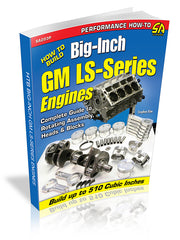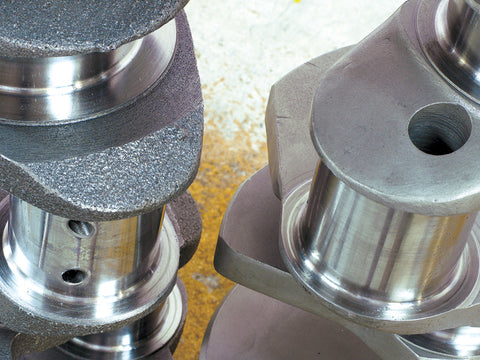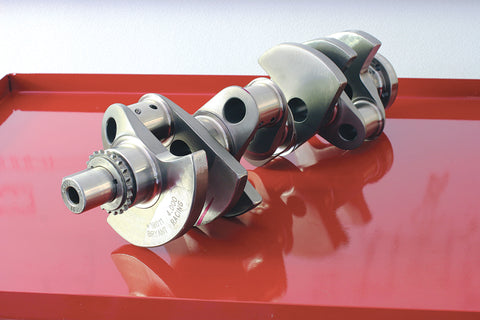Selecting a Big-Inch GM LS-Series Stroker Crank
When selecting a stroker crank, there are many aspects to consider. Once you determine the size of stroker crank (4.000, 4.100, and 4.125 stroker cranks are popular for most platforms), you need to figure out type of crank you will need. The choices for GM LS stroker engines are cast, forgedsteel, and billet steel.
Find more tips like this in the book: HOW TO BUILD BIG-INCH GM LS-SERIES ENGINES
Learn more about building LS-Series engines. Get your copy here!
SHARE THIS ARTICLE: Please feel free to share this article on Facebook, in forums, or with any clubs you participate in. You can copy and paste this link to share: https://www.cartechbooks.com/blogs/techtips/gmsstrokercranks
Cast vs. Forged vs. Billet
When comparing a cast crank (left) to a forged crank (right), it’s obvious why the forged unit fetches a higher price tag. The cast crank’s rough surface shows that very little finishing machine work is required, as the casting process yields a shape that closely resembles the end product. The forged crank’s smoother and more refined appearance reveals the extensive machining operations required after the crank leaves the forging die.
Two of the most important factors that determine the strength of a crankshaft are the material it’s made from and how that material is processed. Casting and forging are the two most common manufacturing methods, and each has its benefits and drawbacks. Cast cranks start life as liquid iron or steel, which is poured into a mold. This allows the raw casting to closely resemble its final shape, which reduces the amount of final machining required. Because the equipment necessary to produce cast cranks is relatively inexpensive, it’s obvious why they’re the predominant choice of the OEMs, including GM. Aftermarket cast steel cranks offer significant improvements in strength, and they can be had for as little as $500.
In contrast, the forging process requires heavy-duty presses and more extensive final machining operations. Forging involves heating a cylindrical slug of metal to a molten state, then pounding it into shape with 200-ton presses and dies. It is this compressing action that creates an inherently stronger end product over a casting. In a casting, the grain structure is very loosely held together. In a forging, the force of the press compresses the grain together, so it becomes one uniform grain flow. As the space between the molecules is compressed, they are forced to bond together, which dramatically improves strength. In fact, forged small-block cranks routinely handle in excess of 1,000 hp.
Compared to a cast crank, the drawback of a forging is cost. The heavy-duty hydraulic presses used in the forging process cost at least $100,000, so aftermarket manufacturers must sell vast quantities of cranks before they even recover their equipment costs. This leads to a costlier product, typically about $900.
Distinguishing a cast crank from a forged unit at the swap meet or on eBay is easy. Cast cranks have a distinct parting line, a vestige from where the casting cores were separated during the manufacturing process.
Billet cranks are closely related to forged cranks. Like a forging, a billet crank starts out as a large cylindrical ingot of steel. However, while a forged crank is compressed during the forging process, the steel ingot used in a billet crank is already forged, albeit not quite as compressed as in a forged crank. The key difference between the two is how the ingots are shaped into cranks.
The metal bar used to make a forged 4.000-inch Gen III/IV crank measures about 4.75 inches in diameter, and the crank’s total width ends up being 6.75 inches when the forging process is complete. The metal bar used in a billet crank of the same stroke is much larger at roughly 8 inches, and it weighs 350 pounds, compared to the 150-pound metal bar used to make a forged crank.
Instead of twisting and pounding the metal in different directions as done in forging, a CNC mill whittles away the metal of a billet crank into its final shape, so the grain structure runs parallel throughout the entire length of the crank. Due to the increase in materials and labor over a forged crank, billet cranks are the most expensive of them all. Custom one-offs carry price tags in the neighborhood of $3,000.
Find more stories like this in the book: HOW TO BUILD BIG-INCH GM LS-SERIES ENGINES
Learn about sheet metal projects. Get your copy here!
SHARE THIS ARTICLE: Please feel free to share this article on Facebook, in forums, or with any clubs you participate in. You can copy and paste this link to share: https://www.cartechbooks.com/blogs/techtips/gmsstrokercranks
A price tag that steep makes a billet crank impractical for the average street/strip motor. If money is no object, however, billet cranks represent the pinnacle in strength. By nature, a forging is not as strong as billet, because the forging process stretches and shears the grain structure. A forging starts out as a round bar of metal and gets twisted and turned to make the rod throws. What used to be centerline of the bar is now offset, and the grains get stretched, traumatized, and weakened, although some sections of it are substantially stronger than those in a casting. With billet, there are no stress riser areas, because the grain structure runs parallel to the length of the entire crank. Forgings are stronger than billet in bolts and axles, because the metal isn’t stretched and sheared, but not in crankshafts. The most demanding forms of racing—including NHRA Top Fuel, NASCAR Sprint Cup, and Formula One—all rely on billet cranks.
Billet cranks, like this 4.000-inch unit from Bryant Racing, offer the ultimate in strength. However, a custom billet crank costs $2,000 to $3,000, and a forged unit works just as well for most street motors at a fraction of the price.
Remember, the crankshaft is the foundation of the rotating assembly, and while most engine builders are on a budget, you need to invest the money in the best crank for your particular application high-performance street, street/strip, and race. So, be sure to choose wisely.
Find more stories like this in the book: HOW TO BUILD BIG-INCH GM LS-SERIES ENGINES
Learn about sheet metal projects. Get your copy here!
SHARE THIS ARTICLE: Please feel free to share this article on Facebook, in forums, or with any clubs you participate in. You can copy and paste this link to share: https://www.cartechbooks.com/blogs/techtips/gmsstrokercranks





